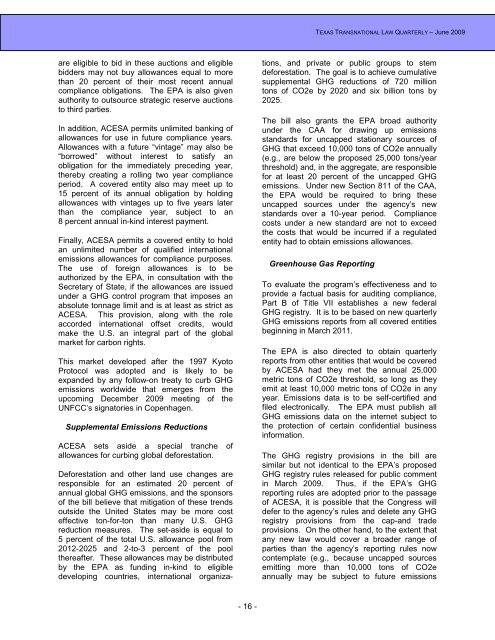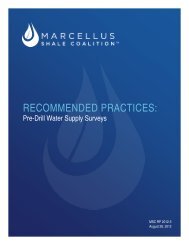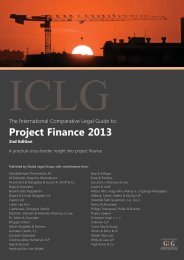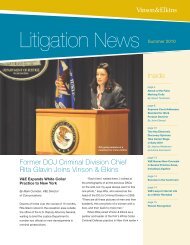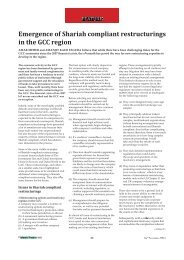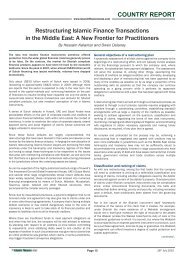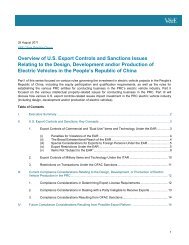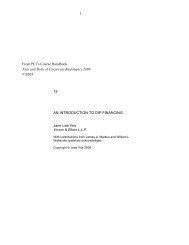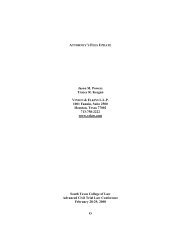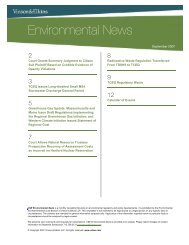TEXAS TRANSNATIONAL LAW QUARTERLY - Vinson & Elkins LLP
TEXAS TRANSNATIONAL LAW QUARTERLY - Vinson & Elkins LLP
TEXAS TRANSNATIONAL LAW QUARTERLY - Vinson & Elkins LLP
You also want an ePaper? Increase the reach of your titles
YUMPU automatically turns print PDFs into web optimized ePapers that Google loves.
<strong>TEXAS</strong> <strong>TRANSNATIONAL</strong> <strong>LAW</strong> <strong>QUARTERLY</strong> – June 2009are eligible to bid in these auctions and eligiblebidders may not buy allowances equal to morethan 20 percent of their most recent annualcompliance obligations. The EPA is also givenauthority to outsource strategic reserve auctionsto third parties.In addition, ACESA permits unlimited banking ofallowances for use in future compliance years.Allowances with a future “vintage” may also be“borrowed” without interest to satisfy anobligation for the immediately preceding year,thereby creating a rolling two year complianceperiod. A covered entity also may meet up to15 percent of its annual obligation by holdingallowances with vintages up to five years laterthan the compliance year, subject to an8 percent annual in-kind interest payment.Finally, ACESA permits a covered entity to holdan unlimited number of qualified internationalemissions allowances for compliance purposes.The use of foreign allowances is to beauthorized by the EPA, in consultation with theSecretary of State, if the allowances are issuedunder a GHG control program that imposes anabsolute tonnage limit and is at least as strict asACESA. This provision, along with the roleaccorded international offset credits, wouldmake the U.S. an integral part of the globalmarket for carbon rights.This market developed after the 1997 KyotoProtocol was adopted and is likely to beexpanded by any follow-on treaty to curb GHGemissions worldwide that emerges from theupcoming December 2009 meeting of theUNFCC’s signatories in Copenhagen.Supplemental Emissions ReductionsACESA sets aside a special tranche ofallowances for curbing global deforestation.Deforestation and other land use changes areresponsible for an estimated 20 percent ofannual global GHG emissions, and the sponsorsof the bill believe that mitigation of these trendsoutside the United States may be more costeffective ton-for-ton than many U.S. GHGreduction measures. The set-aside is equal to5 percent of the total U.S. allowance pool from2012-2025 and 2-to-3 percent of the poolthereafter. These allowances may be distributedby the EPA as funding in-kind to eligibledeveloping countries, international organiza-tions, and private or public groups to stemdeforestation. The goal is to achieve cumulativesupplemental GHG reductions of 720 milliontons of CO2e by 2020 and six billion tons by2025.The bill also grants the EPA broad authorityunder the CAA for drawing up emissionsstandards for uncapped stationary sources ofGHG that exceed 10,000 tons of CO2e annually(e.g., are below the proposed 25,000 tons/yearthreshold) and, in the aggregate, are responsiblefor at least 20 percent of the uncapped GHGemissions. Under new Section 811 of the CAA,the EPA would be required to bring theseuncapped sources under the agency’s newstandards over a 10-year period. Compliancecosts under a new standard are not to exceedthe costs that would be incurred if a regulatedentity had to obtain emissions allowances.Greenhouse Gas ReportingTo evaluate the program’s effectiveness and toprovide a factual basis for auditing compliance,Part B of Title VII establishes a new federalGHG registry. It is to be based on new quarterlyGHG emissions reports from all covered entitiesbeginning in March 2011.The EPA is also directed to obtain quarterlyreports from other entities that would be coveredby ACESA had they met the annual 25,000metric tons of CO2e threshold, so long as theyemit at least 10,000 metric tons of CO2e in anyyear. Emissions data is to be self-certified andfiled electronically. The EPA must publish allGHG emissions data on the internet subject tothe protection of certain confidential businessinformation.The GHG registry provisions in the bill aresimilar but not identical to the EPA’s proposedGHG registry rules released for public commentin March 2009. Thus, if the EPA’s GHGreporting rules are adopted prior to the passageof ACESA, it is possible that the Congress willdefer to the agency’s rules and delete any GHGregistry provisions from the cap-and tradeprovisions. On the other hand, to the extent thatany new law would cover a broader range ofparties than the agency’s reporting rules nowcontemplate (e.g., because uncapped sourcesemitting more than 10,000 tons of CO2eannually may be subject to future emissions- 16 -


